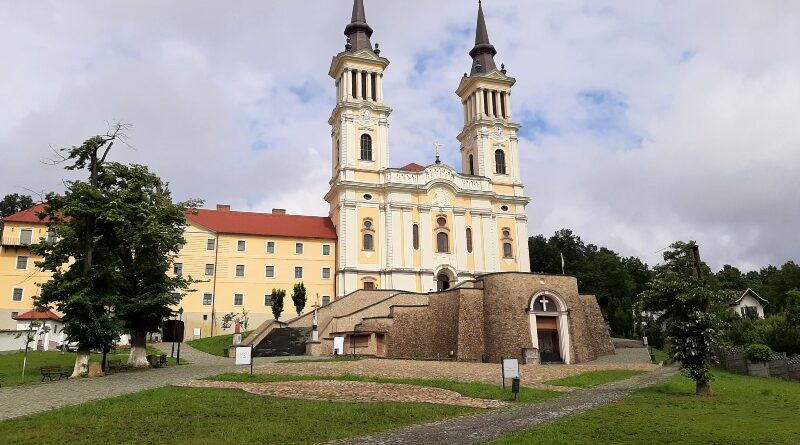Maria Radna Church and Monastery – A Place for Pilgrimage Defying Borders
In this destination guide we will visit the Maria Radna Church and Monastery near Arad.
Arad day trip
If you find yourself in the surprisingly beautiful Romanian city of Arad, one of the best possible day trips you can make is to the municipality of Lipova.
Lipova, which exists out of the town of Lipova proper and the neighbouring villages of Radna and Şoimoş, has two highly interesting sights which most foreign tourists will probably have never heard of, but are well-worth seeking out.
One of them is the Maria Radna Church and Monastery, an important regional pilgrimage site, the other one being the hilltop castle ruins of Şoimoş.

Getting there and back
Although going to Lipova by car would of course offer you more flexibility, it is perfectly feasible to visit both Radna and Şoimoş by public transport in an easy day trip.
From Arad’s railway station, it takes just 40 minutes by train to reach Radna, with a one-way ticket costing between 5.3 RON (1.10 EUR) and 14.5 RON (3 EUR) depending on which train you choose.
You can book tickets online in advance through the website of the Romanian Railways, although it is perfectly possible to buy the tickets on the spot at the station.
Do however note that the train schedule is rather thin. There are currently trains from Arad to Radna departing at 05.40am, 9.06am and 2.41pm, making the nine o’clock train the only realistic day trip option.
On the way back, there are a couple more options, with trains departing Radna for Arad at 1.46pm, 1.56pm, 3.20pm – and then a big gap in the timetable until the 9.08pm evening departure as the last train of the day.
I decided not to buy my ticket from Radna back to Arad in advance, as I wasn’t sure whether I would already be finished sightseeing at 1.46pm or if perhaps the 3.20pm train would be a better bet.
It’s probably best not to buy this ticket in advance but to do so on the spot in Radna depending on how long you will take seeing the sights. However, I strongly advise to at least look up the timetable in advance – as the last thing you probably want is to find out you just missed the afternoon train and have to wait for five or six hours more until the evening departure!
Train trip
The train journey itself is perfectly pleasant, although this being a secondary route in Romania you should definitely expect some ageing, grubby trains.
At first the views out of the window are rather boring flat fields, but this quickly gives way to the rolling hills of the Mureș River Valley in which Radna is located.
In Romania, there are no announcements for stops on trains, so do pay attention where you are on the route (and to the clock) in order to get off at the right station!
Upon arrival it started to rain cats and dogs, so I decided to take some shelter beneath the train station’s roof for a while until it was dry enough to set off on foot into town.



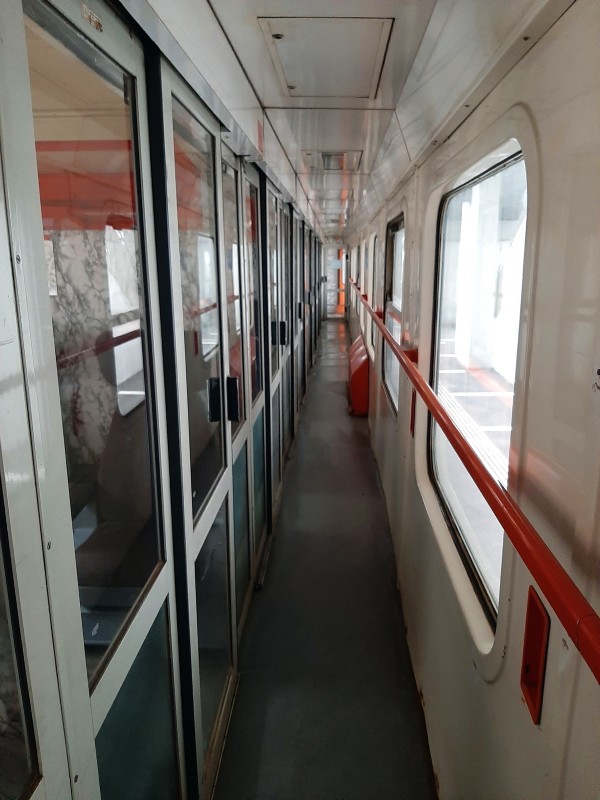


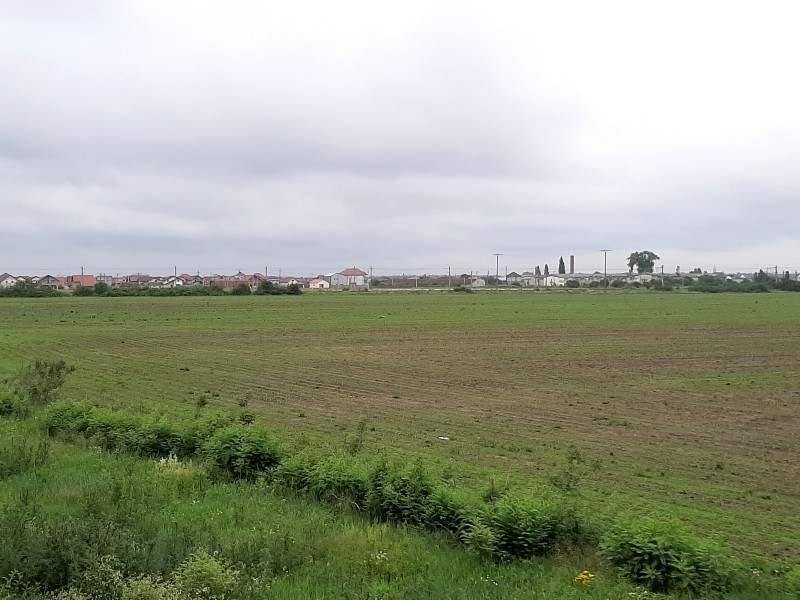
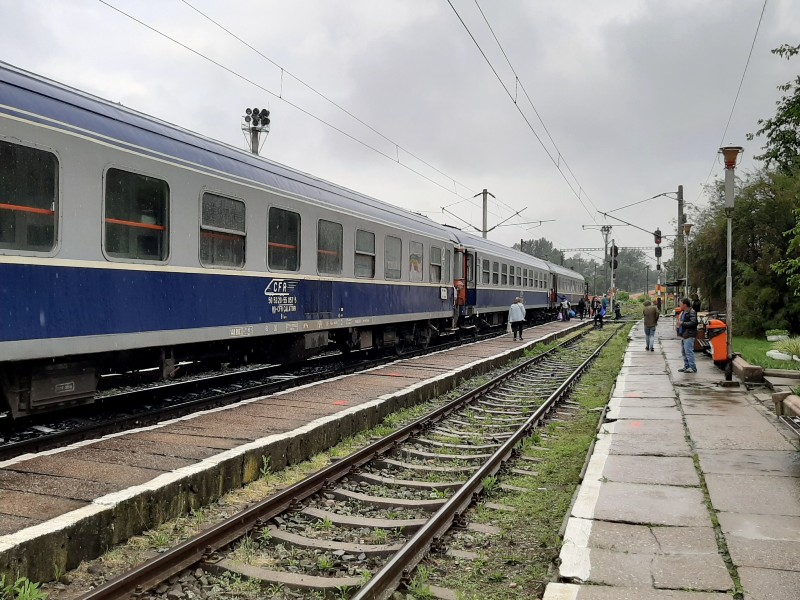

To the church
From Radna’s train station it is a straightforward and pleasant 10 minute walk to the Maria Radna Church and Monastery. With the spires of the church being visible from a distance away, you cannot really miss it.
With its yellow-and-white pastel colours and grand staircase in front of it, the church looks quite striking and is certainly beautiful.


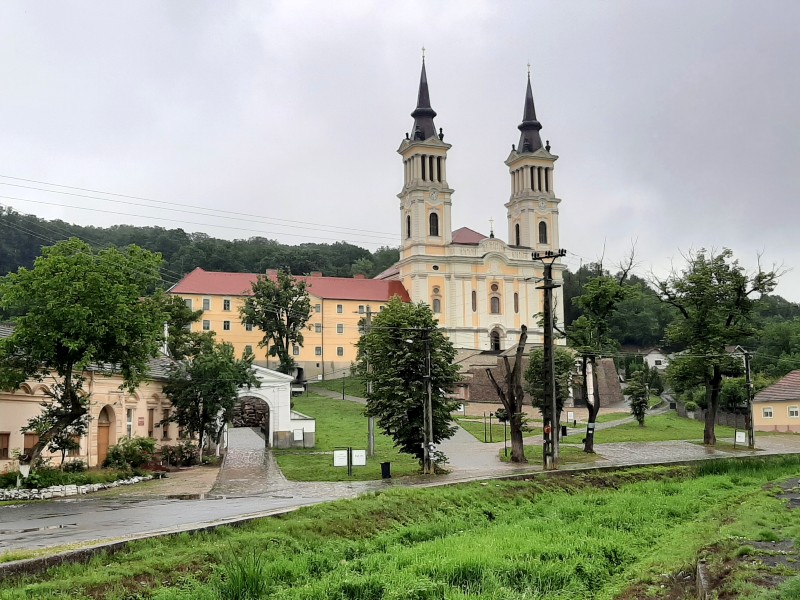
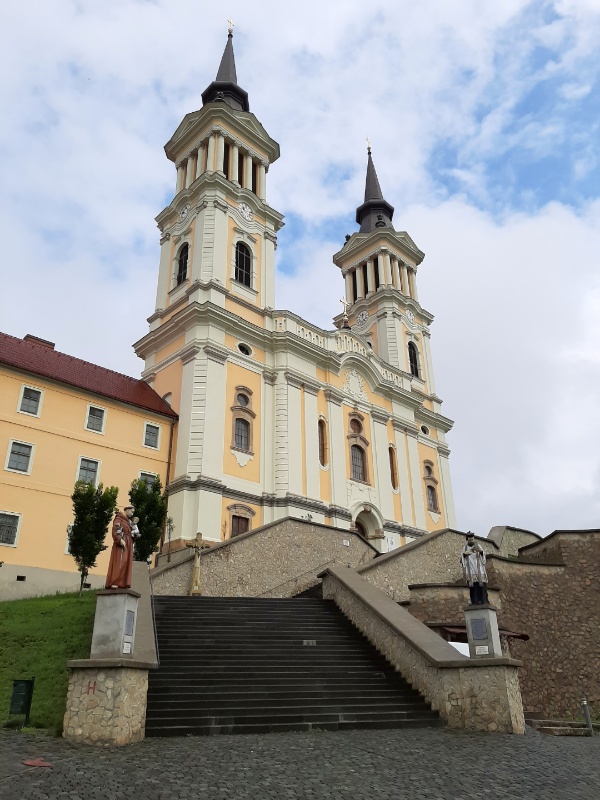
Habsburgs
With Romanians being by and large Orthodox, the Catholic Maria Radna Church was mainly built for the area’s Hungarian and Swabian German inhabitants.
Although especially the Swabians have dwindled in numbers since the breakup of the Austro-Hungarian Empire and fall of communism in Romania in 1989, both groups basically formed the local ruling class in the years of the Habsburg Empire.
The popularity of Maria Radna as a place of pilgrimage reflects the Habsburg history, as Catholics from the wider border area, including those living in Serbia and Hungary, but even as far as Croatia and Austria, regularly flock to this church to pay homage to Mary. And although Maria Radna is a Catholic church, even many Romanian Orthodox believers make a pilgrimage here.
The history of Christianity in the area however predates the Habsburgs as already in 1030 the Cenad Diocese was founded to which Radna belonged. Only after World War I and the breakup of the Austro-Hungarian Empire in the Trianon Peace Treaty of 1920, was this diocese split along the new national borders, with Radna belonging to the Timisoara Diocese since then.
A bit of history
Radna always had deep ties with Saint Mary (Sfânta Maria in Romanian) so it’s not a big surprise that an entire church and monastery have been dedicated to her.
Already in 1278, a consecrated church was built in the honour of the Blessed Virgin Mary, which back then was taken care after by the monks of the Order of St. Augustine.
In 1520 a pious widow decided to build a small chapel dedicated to Mary in town as well. After the Banat was conquered by the troops of the Ottoman Empire following the battle of Mohács in 1526, the chapel served as a place of refuge for the local faithful as well as for some Franciscan brothers who had fled the violence.
When things settled down during Ottoman occupation, a large group of skilled Bosnian tradesmen were allowed to settle in Radna. Due to their influential position and valuable work they performed, these tradesmen were given special privileges from the Sultan. One of these privileges was that a group of Bosnian Franciscan monks could silently assist their people with tacit approval of the Ottomans.
In the year 1668 a merchant donated an Italian-made icon of the Virgin Mary to the local Franciscan Order. When the original Maria Radna Church was burned down by the Ottomans in 1695, the image of Mary miraculously survived the fire. Since then, believers have ascribed miraculous powers to this icon.
It resulted in Radna slowly becoming a place of pilgrimage for those wanting to pray to the Blessed Virgin Mary. When the Habsburg Empire finally reconquered the lands from the Ottomans, they started in 1756 to construct a brand new church to host the icon.
In 1992 Pope John Paul II granted the pilgrimage church Maria Radna the title of Basilica minor. However, in 2013 the Franciscan Brothers left the adjacent monastery after a presence stretching many centuries, being unable to find new monks to supplement the ageing brothers.
A look inside the church
The Maria Radna Church is open to visit for everybody. Mass is regularly held in the church in three different languages: Romanian, Hungarian and German.
Some of these ethnicities have their own pilgrimage days, with the German faithful for example going on pilgrimage on 2nd August, the Hungarians on October 8th and a group all the way from Slovakia on August 10th.
Upon entering Maria Radna, I got into a pleasant conversation with the Hungarian sacristan of the church. Speaking Hungarian, Romanian as well as fluent German, the caretaker gladly took the time to tell some stories about the church being happy that a foreigner took the time to visit his church on this rainy day in May.
He also unlocked a gallery to the side of the church which was full of donated paintings, woodworks and embroideries by believers from all over the former Habsburg Empire, all thanking Maria Radna for helping them overcome difficult times in their lives.
Although I didn’t visit it due to only having limited time and it being rainy, there is also a Way of the Cross on the forested hill right behind the monastery which is worth checking out.
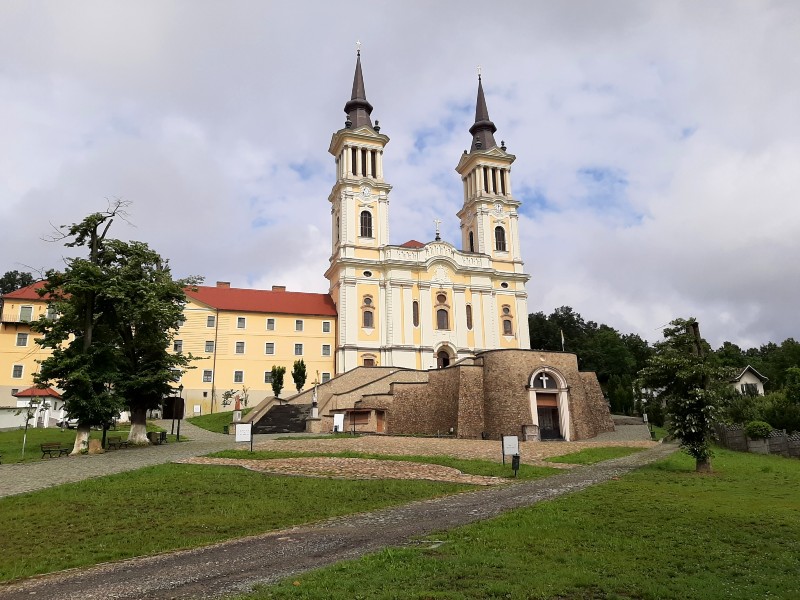
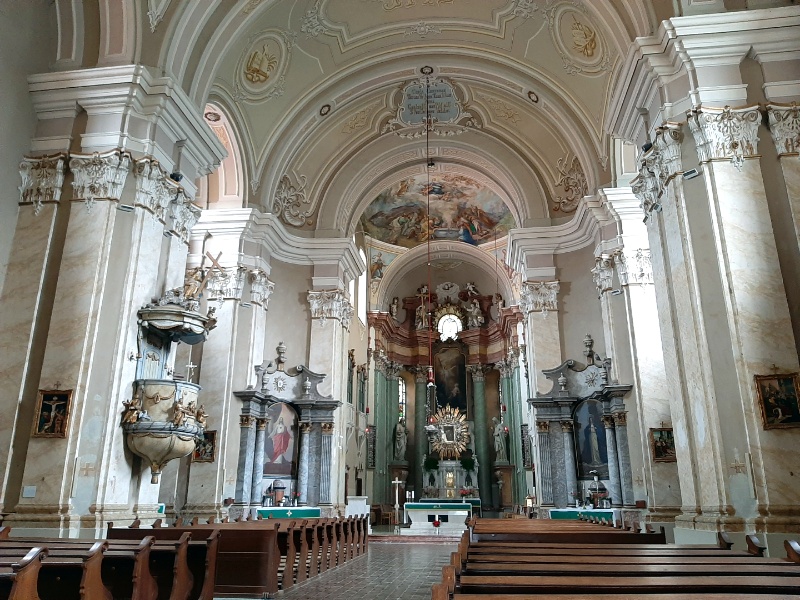
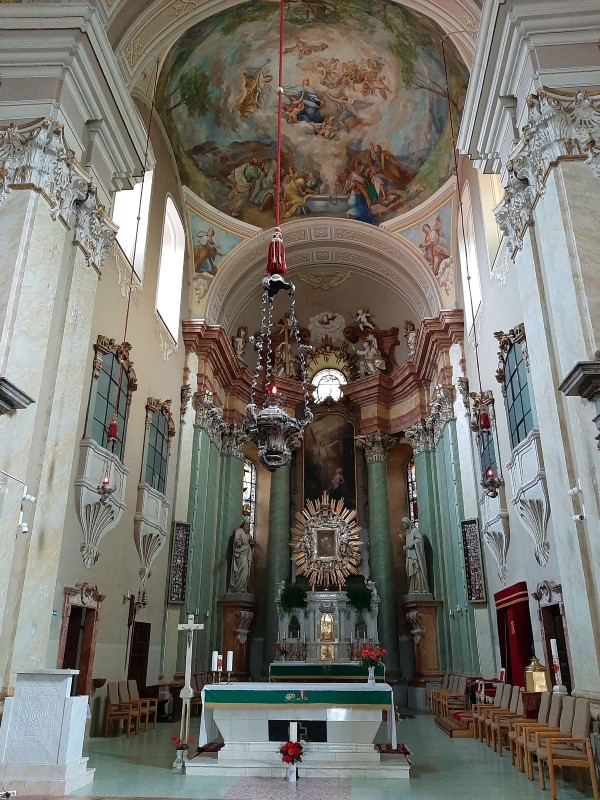



On to Şoimoş
Having thanked the sacristan for the nice chat and his little tour of the church, it was time to leave Radna and walk the short distance to nearby Şoimoş to visit the castle ruins of Cetatea Șoimoș (Șoimoș Fortress).
For more on the fortress and the conclusion of my day trip, do read on to the next chapter!

In short
Whether you are religious or not, Maria Radna makes for an interesting visit. Combined with Șoimoș, it is an easy and relaxed day trip from the nearby city Arad, whether you go by public transport or have your own set of wheels.
The Maria Radna Church and Monastery is arguably a beautiful church with an interesting history. If you happen to speak Romanian, Hungarian or German, you are likely to find someone who can explain much more about the local traditions.
The church location in a small Romanian town also makes for an excellent contrast to the city surroundings of Arad, especially if you have never set foot outside a Romanian city before.
Explore some other destinations with us!
In our trip report section, we have written multiple diary accounts of holidays across the world which can serve as an inspiration for your next trip. These trip reports include destination guides such as this article, as well as reviews of hotels, airlines and other modes of transport.
At Paliparan, we also regularly publish amazing flight deals and special ticket sales, so make sure to regularly check the flight deals section on our website.
Or subscribe to our Facebook, Instagram or Twitter pages to receive instant updates when a new article or flight deal is out!

